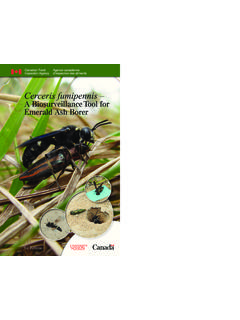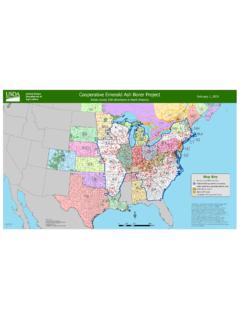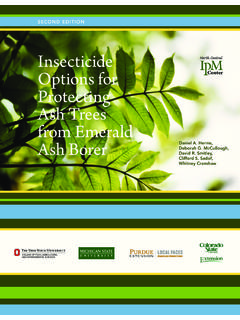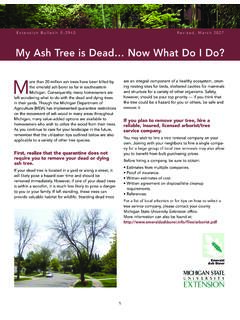Transcription of Distinguishing Ash from Other Common Trees
1 11111 Distinguishing Ash fromother Common TreesIdentification keyBegin at number 1 on the key and choose (a) or (b). Thenproceed to the number listed in italics at the end of yourchoice. This number will give you a new set of this way through the key. We have listed enoughcharacteristics to help you determine whether or not your treeis an ash. If it doesn t match the characteristics in the key,relax; it most likely isn t an ash. If you don t want to use the1. a) Branches alternate (Fig. 1) go to 2b) Branches opposite (Fig. 2) go to 42. a) Simple leaves, with irregular leaf base andtoothed edge (Fig. 3). See elm, page ) Compound leaves (Fig. 4), with 9 to 15 leaflets,finely toothed around edge of leaf go to 3c) Compound leaves, 5 to 7 leaflets go to ) Cut open twig pith (Fig.
2 6). See black walnut, page 3. Alternate leaves/branches that are staggered or not directly across from each Other , Fig 1. Opposite leaves/branches that are directly across from each Other , Fig. 2. Simple a single leaf blade joined by its stalk to a woody stem, Fig 3. Compound a leaf with more than one leaflet. All leaflets attached to a single leafstem, Fig. ash treesDue to the recent discovery of the emerald ash borer(EAB) in Michigan, it is important to be able to recognizeand identify ash Trees . To date, emerald ash borer has onlybeen found on ash Trees (see page 4). Not sure if your tree isan ash? This simple key is intended to help you distinguishbetween some Common deciduous landscape Trees frequentlyconfused with ash, including: elm, boxelder, mountainash,walnut and the identification keykey, tree ID photos are on pages you are still curious about what kind of Trees you have,consult Extension Bulletin E-2332, Identifying Trees ofMichigan, or a good field guide such as: The TreeIdentification Book, by George Symonds; TreeFinder: A Manual for the Identification of Trees by TheirLeaves, by May T.
3 Watts; or A Field Guide to Trees andShrubs by George A. Petrides. There are many Other goodguides available; these are mentioned only as ) If pith is not chambered, but has white flowers in May,orange or red berries in fall. See mountainash, page ) If pith is not chambered, but has three leaflets at end ofleaf larger than the rest. See hickory, page ) Compound leaves, 5 to 9 leaflets, smooth or finely toothedaround outer edge. See ash, page ) Compound leaves, 3 to 5 leaflets, few coarse teeth or none,end leaflet pointed (Fig. 5). See boxelder, page 1- AlternatebranchingFig. 2- OppositebranchingFig. 3- Simple leaf( american elm)Fig. 4- Compoundleaf, 7 leaflets(White ash)Fig. 5- Compound leaf,3 leaflets (Boxelder)Fig.
4 6- Chamberedpith (Black walnut)Diane Brown-Rytlewski and Rebecca ThompsonMichigan State University IPM ProgramMSU Extension Bulletin E-2892, New May 2003 Line drawings: Steven BrownAlternate branchingBranches and buds are alternate and leaf bases are unequal. The leaves are simple,serrate (toothed) and 3 to 6 inches long and 1 to 3 inches wide ( american elm) or3/4 to 3 inches long and 1/3 to 1 inch wide (Siberian elm). The fruit is a winged : american elm has a vase-shaped growth habit. Right: Siberian elmsare fast-growing, brittle Trees that break easily. Other elms will havesimilar leaves and seeds, although leaf size and growth habit will , Ulmus , Carya hickory has distinctive bark long, loose, shaggy strips.
5 Leaves arecompound, 8 to 14 inches long with 5 to 7 leaflets. The three terminal leaflets arelarger than the Other leaflets. Other similar species (not shown) include bitternut,pignut and mockernut, which have similar leaves and fruits although leaf size willvary. They do not have distinctive shaggy bark. These Trees are seldom planted inlandscapes, but are native, and may be found growing in woods. Fruits are hard-shelled light brown nuts, in a green husk that splits into four leaf baseElm leavesand fruitSandy PerrySandy PerryUGA0008353 Paul WrayUGA0008213 Paul WrayBark of shagbarkhickory treeDiane Brown-RytlewskiMary WilsonHickory fruitHickory leafBranches and buds are alternate. Leaves are compound, 15 to24 inches long, with 9 to 15 leaflets/leaf.
6 Crushed leafletsand stems have a distinct odor similar to turpentine. Twigs,split lengthwise, have chambered pith. Fruit is a large darkbrown nut inside a green walnut, Juglans nigraLeaves are compound, 5 to 9 inches long with 9 to 15 leafletsper leaf. Leaflets are a toothed, rounded oval shape. Flowersare five-petaled, white and similar to cherry or appleblossoms but in clusters. Fruits are fleshy, red-orange berriesin clusters they are found in the mountainash,Sorbus aucuparia33333 Black walnutchambered pithAlternatebranchingBlack walnut fruitUGA0008448 Paul WrayUGA0008279 Paul WrayBlack walnut leafDiane Brown-RytlewskiDiane Brown-RytlewskiMountainash flowersMountainash alternate branchingDiane Brown-RytlewskiMountainash leafBranches and buds are opposite with a single bud at the endof the branch (terminal bud).
7 Twigs are gray to brown and donot have a waxy coating. Leaves are compound, 8 to 12inches long, 5 to 9 leaflets/leaf. Leaves may be finely toothedor have smooth edges. The most Common ash Trees planted inthe landscape are white ash (Fraxinus americana) and greenash (Fraxinus pennsylvanica). Other native ash Trees lesscommonly found include black ash (Fraxinus nigra) andblue ash (Fraxinus quadangulata) (not shown). Black ashhas 7 to 11 leaflets and is found in wet woods; blue ash has 7to 11 leaflets and distinctive 4-angled corky wings on thestem. White ash buds are paired with a leaf scar beneath thebud that looks like the letter C turned on its side. Greenash buds are paired with a leaf scar beneath the bud thatlooks like the letter D turned on its side (like a smile).
8 Individual fruits are shaped like single wings and occur inclusters; many ash cultivars are , Fraxinus is sometimes called ash-leafed maple. The twigsand buds are opposite; with a single bud on the end of thetwig (terminal bud). Twigs are green to purplish brown, andoften have a waxy white coating that can be rubbed off theBoxelder, Acer negundostem. Leaf scars beneath the buds are narrow, and join in apoint. Leaves are compound, 4 to 10 inches long, with 3 to 5leaflets/leaf. Leaves may have a few coarse teeth, or end leaflet is sharply pointed. Fruit is a paired wingedseed, occurring in ash leafOppositebranchingWhite ash leafLeft: green ash leafscar. Right: white ashleaf seeds44444 MSU is an Affirmative-Action Equal-Opportunity Institution.
9 MSU Extension programs and materials are open to all withoutregard to race, color, national origin, gender, religion, age, disability, political beliefs, sexual orientation, marital status, or familystatus. Issued in furtherance of Extension work in agriculture and home economics, acts of May 8 and June 20, 1914, in cooperationwith the US Dept. of Agriculture. Margaret A. Bethel, Extension director, Michigan State University, E. Lansing, MI information is for educational purposes only. Reference to commercial products or trade names does not imply endorsement orbias against those not mentioned. Reprinting cannot be used to endorse or advertise a commercial product or Brown-RytlewskiDave CappaertUGA0008169 Paul WrayUGA0008289 Paul WrayBoxelder leaf,3 leafletsUGA0008303 Paul WrayUGA1219003 Bill CookUGA1219006 Bill CookBoxelder branchesBoxelder fruitPhoto credits:Bill Cook, Michigan State University, Wray, Iowa State University.







